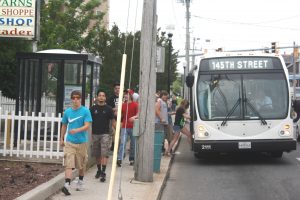
OCEAN CITY — The development of a mobile app allowing the public to track the locations and time estimates for Ocean City municipal buses could be expedited by the recent failures of the town’s existing system for the same purpose.
For the last year or more, Ocean City officials have been exploring an online application for cell phones and other mobile devices that would allow visitors and residents to track the locations of the municipal buses in operation and more accurately estimate their arrival times at bus stops up and down the strip. The city’s transportation sommittee for months has been researching the various companies that provide the service and has narrowed the choice of vendors down to one, but recent glitches throughout the summer in the Auto Vehicle Locator (AVL) system currently used by the city’s transportation department could result in a two-pronged system that would improve the city’s in-house system while providing the same service to the bus-riding public.
During Monday’s meeting, Mayor Rick Meehan said the transportation committee had been getting closer to choosing a vendor to provide the bus-tracking app for the public when it learned the city’s own system had suffered significant downtime this summer. In an office above the south end of the Boardwalk, Ocean City transit officials watch a bank of computer monitors and video screens that allow supervisors to track the locations of the municipal bus fleet traveling up and down Coastal Highway on most busy summer days.
The supervisors use the tracking information to redirect buses currently on the streets to trouble spots and areas where the bus stops are filling up. However, Meehan said on Monday that system had failed on multiple occasions this summer, creating a need to update the town’s current AVL system.
“The one thing to take into consideration is that our current AVL system used by supervisors to track the buses has been failing,” he said. “The company that makes that has been sold and it’s no longer supported, so we’re going to end up needing to replace that AVL system anyway.”
The shortcomings of the AVL system coupled with the desire to provide an online bus tracking system for the public could result in a new system purchased to achieve both goals.
“The other part of this is an online-based system where those who wish to ride the bus will be able to locate them and when a bus will be at a certain bus stop,” said Meehan. “It should really enhance the bus system. We’ve talk a lot about millennials and this really is the next generation in public transportation.”
Ocean City Transportation Director Mark Rickards explained the proposed public bus tracking system would allow visitors and residents to access the information through their phones or other mobile devices, including updates provided through text messages.
“We’ve had the AVL system for our supervisors for about 13 years,” he said. “This whole program is going to open up that information to our 2.5 million riders each year. You’ll be able to look on your phone for the buses either with a map or a text message. This will be really helpful over the summer when we have a ton of visitors, but also year-round when we go down to half-hour service. You’ll be able to track the bus and know when to get to the bus stop.”
Rickards explained the current AVL system utilized by transit supervisors to move the resources around to areas of higher need had suffered considerable failings this summer.
“The current system has had its ups and downs this summer,” he said. “We’ve had about 38 different outages. In the summer, we don’t want to lose track of our buses, but we’ve had 38 outages totaling about 96 hours, some of which were on holiday weekends. By that I mean it just goes black.”
Assistant Transportation Supervisor Brian Connor explained the AVL system outages occurred at some of the most inopportune times.
“We lost a total of 96 hours from Memorial Day to where we are now,” he said. “That’s a substantial block of time our supervisors weren’t able to view and track where our resources were.”
Connor said entering an agreement with the proposed vendor for the public bus-tracking app could include an upgraded AVL system for the bus supervisors. He said the current system is obsolete and the new system could accomplish both goals.
“The equipment we’re using now is really built for truck fleet traffic and the company doesn’t have any plans to make it scalable for public transit,” he said. “The hope of using our existing vendor to achieve that goal really isn’t there. We’ve been digging into this and researching who the leading company on this is and we’ve been able to narrow it down to an effective, responsive vendor that will achieve our goals.”
Purchasing the equipment for both the public bus-tracking app and the city’s own AVL system would come with a price tag of a little over $100,000. While the former might be a nice amenity, the latter is sorely needed by the transportation department. Meehan said the Transportation Committee had forwarded a favorable recommendation to purchase the dual-purpose system to the Mayor and Council and urged his colleagues to approve it.
“Our goal is to have this system installed this fall so we can begin it in the winter, which can really be invaluable for those who want to ride the bus and be able to locate the buses,” he said. “That will allow us to work it out and have it completely ready for the next summer season.”
Rickards explained the cell phone and mobile device app further.
“You can enable your cell phone to pick up text messages,” he said. “It will automatically notify you about how close the next bus is. If you’re at 41st Street, for example, it will notify you there is a bus coming in the next few minutes.”
Councilman John Gehrig, the council’s resident technology expert, provided more insight into how the public access application would work.
“It’s a web app,” he said. “It’s not anything that needs to be downloaded and it’s not taking up memory or space on anyone’s phone. It will allow people to know when to get to the bus stop. It’s a customer service that might not have been mandatory if our current system wasn’t failing.”
Councilman Wayne Hartman raised concerns about how to make the public aware of the availability of the bus-tracking app when there is a constant turnover in population all summer. He referenced other challenging public education efforts to prove his point.
“One of the concerns I have is we talk about our ordinances like the smoking ban on the Boardwalk, for example, and how there are 300,000 new people to educate each week,” he said. “We’re three years in on that and we’re still educating, so how are we going to educate 300,000 new tourists each week about this bus locator app. I see a lot of the same challenges.”
Hartman suggested there was not enough information yet on the unscheduled agenda item and suggested it be moved to a work session for further vetting. The council voted unanimously to move the AVL system discussion to a future work session after a motion by Hartman, who suggested the same goal might be accomplished without a $100,000 investment.
“This is the first I’ve heard this and maybe this needs to be moved to a work session before we agree to purchase the new system,” he said. “In the summer, isn’t there a bus every seven minutes or something like that? If we had a sign at the bus stops that told people a bus should come every seven minutes, wouldn’t that answer a lot of questions without spending the $100,000 on this?”

